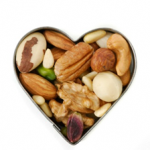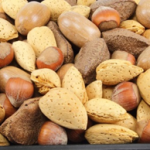
In the last few months, the squirrels have been gathering nuts and putting them away for the cold months ahead. Nuts? Why not corn or beans or apples? Apparently, these “gatherers” know the value of the nut. In fact, several varieties of nuts have been around for thousands of years. The International Tree Nut Council Nutrition and Research & Education Foundation provides the history of many of the nuts that we are familiar with today. For example, did you know that the pistachio has existed for 9,000 years and is one of the oldest edible nuts? It comes in it’s own natural “wrapping” instead of a hard shell like other nuts. Walnuts have been around since 7000 B.C. Pecans were an important part of the Native American’s diet and Thomas Jefferson spent much time cultivating them. Almonds are thought to have originated in China. The hull of the almond protects it from the environment.
The 2010 Dietary Guidelines include nuts as part of a healthy diet. The Choose My Plate website, identifies nuts as part of the protein group of foods. Walnuts, almonds, pecans, peanuts, and pistachios as a source of protein, omega-3 fatty acids, antioxidants, vitamin E, magnesium, copper and folic acid. They have the “good fat.” Nuts are cholesterol free. Much research has been done into the health benefits of consuming nuts. Research has shown that eating nuts is good for heart health. According to the American Heart Association, nuts may lower total cholesterol, raise HDL cholesterol, lower LDL cholesterol and even decrease blood pressure. Research is looking at the role of nuts as it relates to diabetes and cancer and they may reduce the risk of a variety of diseases.
What is a serving? According to the Choose My Plate website, ½ ounce of nuts is considered a “1-ounce equivalent” or about a small handful. The American Heart Association, recommends consuming 4 servings of unsalted, unoiled nuts per week. According to The International Tree Nut Council Nutrition and Research & Education Foundation, a one ounce serving of almonds is about 20 – 24, walnuts 10 -14 halves, or pecans 18 – 20 halves or pistachios about 47 – 49. Yes, you could probably eat more than this! Even though nuts are nutrient dense and have some great health benefits, they can be high in calories! (from the fat). Watch the number of servings (handfuls) you eat! They should be eaten in small portions and can be used to replace other protein foods rather than in addition to. Choose nuts that are unsalted to help reduce the consumption of sodium.

Nuts can be delicious just as is, right out of the shell. But, you can add flavor to everyday foods too! Add some to leafy green salads, chicken or tuna salads, yogurt, vegetables, casseroles, a coating on salmon, in stir fry dishes, or even on top of your breakfast oatmeal. So, be creative! The possibilities are endless! When baking, add nuts to a favorite muffin or cookie recipe. Buy nuts in small quantities. Since nuts have fat in them, they can become rancid and have an unpleasant taste that could ruin a dish. They can easily be stored in the refrigerator. How about toasting some nuts to add some extra flavor? The University of Nebraska Extension has a fact sheet, “Nuts for Nutrition,” that includes “how-to” toast nuts.
Discover the variety of nuts that are available – walnuts, almonds, pistachios, pecans, hazelnuts, cashews, macadamias and pine nuts. All have lots of great taste in small portable packages!

